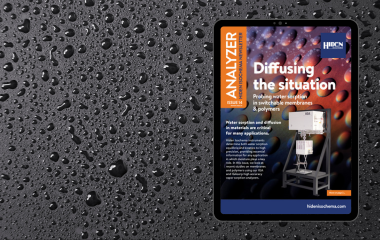What is the Dynamic Vapor Sorption Technique?
The dynamic vapor sorption technique is a gravimetric analysis method used to measure the rate and amount of solvent adsorption by a sample. This is typically performed with water vapor, but other organic solvents can be used.
The technique was first developed as an alternative to desiccators that were used to measure water vapor sorption isotherms. An alternative to desiccators was required due to the time and labor requirements for this method.
This blog post will outline the working principle and applications of dynamic vapor sorption in more detail.

Working Principle of Dynamic Vapor Sorption
Dynamic vapor sorption determines the solvent adsorption by changing the vapor concentration around the sample, and then the change in sample mass is measured. The amount of water adsorbed can be described as the hygroscopicity of the sample, and this property can highlight the formation of hydrates, desalting, crystalline transformation, and faster reaction rates.
As we’ve already mentioned, dynamic vapor sorption is typically used with water vapor, to measure water sorption isotherms. A sorption isotherm describes the quantity of adsorbate on the adsorbent as a function of its concentration at a constant temperature.
The water sorption isotherm indicates the relationship between the equilibrium water content and the equilibrium humidity of the material. The sorption isotherm shows the water content at each humidity value, and the water vapor is often expressed as the relative humidity.
To determine the water vapor sorption, the dynamic vapor sorption technique involves exposing the sample to a series of relative humidity changes and recording any mass change as a function of time. At each change in humidity, the sample must reach gravimetric equilibrium before the next humidity change. The water sorption isotherm is then generated using the equilibrium mass value at each relative humidity.
As the water vapor isotherm has been generated, the sorption rate constant and vapor diffusion coefficients are also determined, which are both important properties of the material.
The difference between the adsorption and desorption isotherms is known as hysteresis, and this can provide further information about the sample porosity and sorption mechanism.
Dynamic Vapor Sorption Applications
The dynamic vapor sorption technique finds use in a range of different industries. The pharmaceutical industry uses the method when determining the performance of drug formulations, excipients, and packing films. Any moisture-induced phase changes of these products can have an adverse effect on the mechanical properties, altering the dosage, yield and purity calculations.
The packaging industry is another sector that uses dynamic vapor sorption to ensure products are performing efficiently. The moisture and diffusion properties of packaging are important, especially for the food industry to ensure the food has the longest shelf life possible. Dynamic vapor sorption can be used to determine these properties using either moisture vapor transmission rate (MVTR) technique or from the sorption kinetics.
Dynamic vapor sorption is also used in the aerospace sector to determine the water transport and diffusion of the composite materials increasingly used for aircraft construction. This information is vital for manufacturers in the aerospace industry, as the stability of these composites when exposed to cycles of moisture and temperature can be affected.
Dynamic Vapor Sorption from Hiden Isochema
Hiden Isochema is a global leader in the development of dynamic vapor sorption instruments. Our IGASORP range are fully automated and have unrivalled performance both in terms of accuracy and stability. If you would like any more information about our range of dynamic vapor sorption instruments, please contact us.


